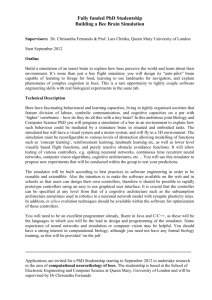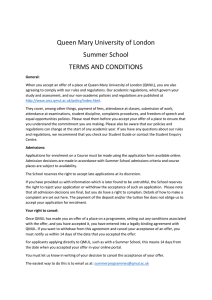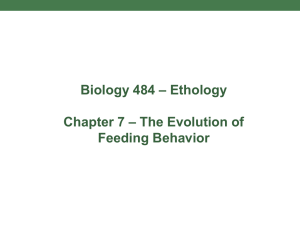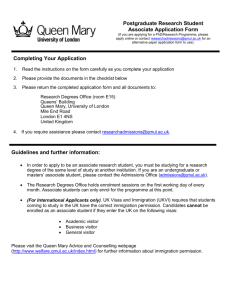BTG Brochure
advertisement
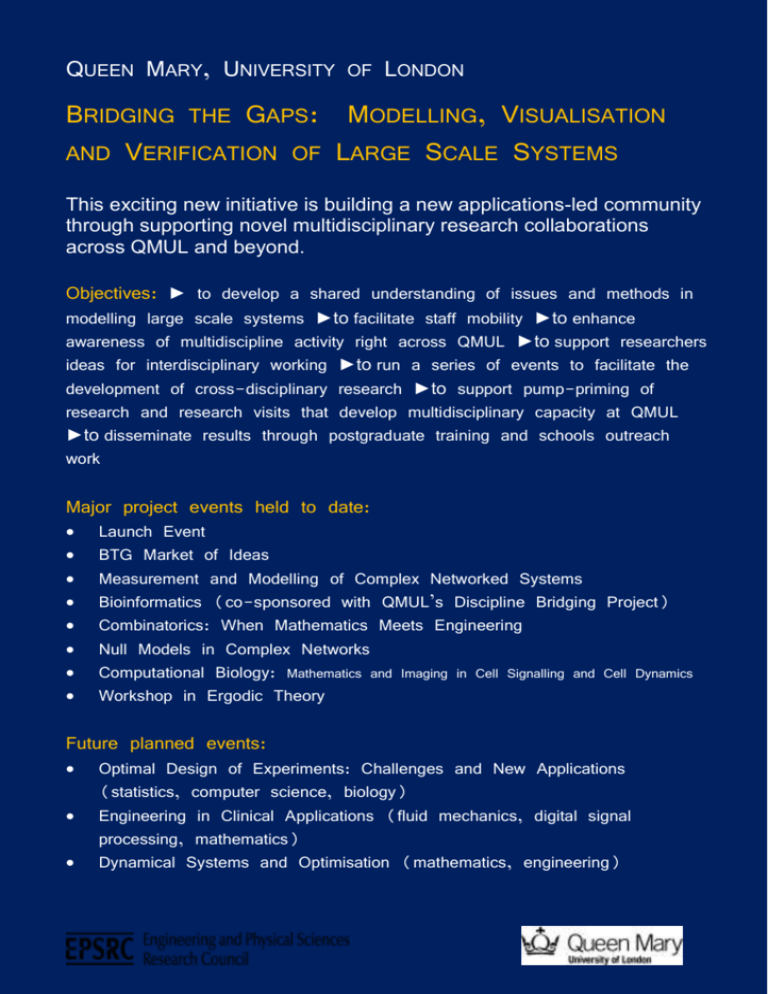
QUEEN MARY, UNIVERSITY OF LONDON BRIDGING THE GAPS: MODELLING, VISUALISATION AND VERIFICATION OF LARGE SCALE SYSTEMS This exciting new initiative is building a new applications-led community through supporting novel multidisciplinary research collaborations across QMUL and beyond. Objectives: ► to develop a shared understanding of issues and methods in modelling large scale systems ►to facilitate staff mobility ►to enhance awareness of multidiscipline activity right across QMUL ►to support researchers ideas for interdisciplinary working ►to run a series of events to facilitate the development of cross-disciplinary research ►to support pump-priming of research and research visits that develop multidisciplinary capacity at QMUL ►to disseminate results through postgraduate training and schools outreach work Major project events held to date: Launch Event BTG Market of Ideas Measurement and Modelling of Complex Networked Systems Bioinformatics (co-sponsored with QMUL’s Discipline Bridging Project) Combinatorics: When Mathematics Meets Engineering Null Models in Complex Networks Computational Biology: Mathematics and Imaging in Cell Signalling and Cell Dynamics Workshop in Ergodic Theory Future planned events: Optimal Design of Experiments: Challenges and New Applications (statistics, computer science, biology) Engineering in Clinical Applications (fluid mechanics, digital signal processing, mathematics) Dynamical Systems and Optimisation (mathematics, engineering) Complexity Science in Policy Making (networks, social sciences, public health) Wireless Body Area Networks in Healthcare (electronic engineering, clinical sciences) Measurement and Modelling of Complex Networked Systems – follow up (engineering, mathematics, electronic engineering, computer science) Imaging and Visualisation for Biofeedback and Learning (multimedia DSP, virtual reality, cognitive and sport psychology, motor rehabilitation) Projects funded to date: Personalised Research Dashboard. The aim of this project is to develop a Personalised Research Dashboard providing a dynamic self-updating environment in which researchers get most up-to-date highly-specialised information. The two main goals of the project are to develop self-organising network and group infrastructure, and the mechanism for personalised intelligent news feed by referrence to the network and group definition. This project is inter-disciplinary with maths and computer science. Has led to a First Grant Proposal by Tokarchuk on “Social and Temporal Recommendation”, supported by BT and Last.FM. Also internal ESD funding for research paper recommendation, and a collaboration with the Food, Consumer Behaviour and Health Research Group at the University of Surrey. Terahertz imaging for molecular dynamics. A longstanding interest in the biological community is the need for automated, high throughput diagnostics, which rapidly characterises the interplay of physiological cellular protein dynamics in response to mechanoelectrochemical forces with non-invasive dynamic control. Potential applications include detecting single base mutations in genetic sequences or monitoring gene sequences as efficient diagnostic devices. A major challenge will be the distinction of the DNA strands within a sample volume without the need for functionalised/labelled probes. This project applies Dispersive Fourier Transform Spectroscopy (DFTS) to biological ‘targets’. The project seeks to make the first DFTS measurements on appropriate proteins in order to correlate absorption spectra with functional behaviour of the protein. As part of the project a THz imaging apparatus will be developed to enable imaging of samples in liquid phase. Part of this work has been in collaboration with the National Physics Laboratory. Statistical physical analysis of the dynamics of foraging bumblebees. Foraging bumblebees need to visit hundreds or even thousands of flowers every day to collect food, nectar and pollen. But, predatory crab spiders may be hiding on some of these flowers waiting to catch unsuspecting bees. Fortunately for bees, most attacks by spiders fail giving bees the opportunity to learn to recognise and avoid these dangerous predator. However, some spiders can potentially make this task even more difficult by changing their colour to match that of the flower they are sitting on. Therefore, in this experiment we set out to test whether spider camouflage does in deed hinder bees' ability to learn to avoid these dangerous predators. This project is developing probabilistic models of bee foraging that it is foreseen will have wider applicability, e.g. in network science. Accurate landmark localization and registration of 3D facial scans for the evaluation of orthodontic treatments in maxillofacial and oral surgery. This project is improving an image analysis tool developed in the SEECS for the localisation of facial landmarks on 3D scans. Automated localisation eases the burden on clinicians who analyse the data and more importantly improve the accuracy of scan comparison. The project is half-way through and our achievements so far are: improved the analysis tool to detect facial landmarks with better accuracy; made the tool more user-friendly with the inclusion of user feedback. Our current work (second half of the project) involves clinical evaluation of the landmark detection accuracy. Finally, we will use the improved landmark detection process to improve the accuracy of 3D facial scan registration for the analysis of patient data. The figure shows a comparison of the proposed registration results with a baseline algorithm (ICP). Our registration provides results consistent with the morphological knowledge of the person under study, as the cheek region consists of soft tissue which has changed over time, while the upper regions of the face consist of hard tissue which is known to be invariant. A change is seen in the eye region as the eyes are closed in one scan, and open in the other. Coagulation and Communications. Trauma is one of the world's leading causes of death and disability. Some trauma patients develop a profound derangement of their ability to form blood clots, associated with a 4-fold increased likelihood of dying. The traditional description of the coagulation protein-protein interactions as a cascade model is incorrect. Now it is known that human coagulation network has typical properties of a complex network. The aim of this project is to apply complex networks science to analyse and describe the coagulation metabolic network and obtain a representation that captures the dynamics of haemostasis. Interdisciplinary with trauma surgeon – Prof Karim Brohi. Computational Flow Simulations in Cerebral Aneurysm Treatment. have a high rate of mortality in case they rupture. However there is no consensus about when to treat un-ruptured aneurysms. Recent studies have proposed that hemodynamic factors such a wall shear stress induced by the flow or intraaneurysm pressure play a major role in aneurysm rupture. Recent interest has been focussed on the patient-specific approach in which the actual vessel geometry is extracted from a CT or MRI scan of a specific patient. This promises high accuracy and could be extended to clinical use on a patientper-patient basis. The aim of this Further information: Aneurysms study is to extend research to a larger cohort of subjects in order to confirm the hypothesis that flow sensitivity can be linked to an increased likelihood of aneurysm rupture. The project will involve radiologists and neurologists at Barts who provide the patient data and medical expertise, as well as engineers at SEMS who perform the flow simulations. Dr John Schormans, School of Electronic Engineering and Computer Science Contact: Tijana Timotijevic Project Manager for Bridging the Gaps project School of Electroni Engineering and Computer Science Queen Mary, University of London Mile End Road, London, E1 4NS Tel: +44 (0)20 7882 5332 Fax: +44 (0)20 7882 7997 email: tijana.timotijevic@elec.qmul.ac.uk
